Staphylococcus aureus is an aerobic, spherical, Gram-positive bacterium in the Staphylococcaceae family.
Staphylococcus aureus may elicit skin inflammations (cellulitis, furuncle) and muscle inflammations. In hospitals, it is the most common pathogen of surgical site infections.
Particularly in clinics, Staphylococcus aureus is of major importance. Antibiotic-resistant strains are associated with wound infections hard to treat.
Several Staphylococcus aureus strains are resistant to multiple antibiotics:
- MRSA = Methicillin-resistant Staphylococcus aureus:
Staphylococcus aureus
strains that are resistant to all commercially available beta-lactam antibiotics (e.g. penicillin) - VRSA = Vancomycin-resistant Staphylococcus aureus:
Staphylococcus aureus strains that additionally are resistant to vancomycin
The main transmission path is direct or indirect contact with contaminated persons or objects.
» Necessary spectrum of antimicrobial activity
Bactericidal
Click here to find products with bactericidal activity.


